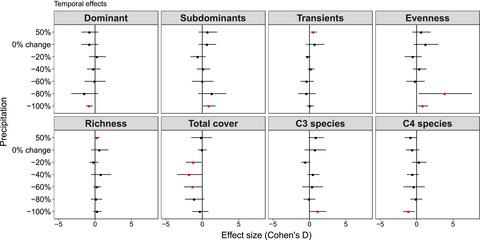当前位置:
X-MOL 学术
›
Ecol. Evol.
›
论文详情
Our official English website, www.x-mol.net, welcomes your feedback! (Note: you will need to create a separate account there.)
Drought mildly reduces plant dominance in a temperate prairie ecosystem across years.
Ecology and Evolution ( IF 2.6 ) Pub Date : 2020-06-01 , DOI: 10.1002/ece3.6400 Karen Castillioni 1 , Kevin Wilcox 2 , Lifen Jiang 3 , Yiqi Luo 3 , Chang Gyo Jung 3 , Lara Souza 1
中文翻译:

多年来,干旱温和地降低了温带草原生态系统中植物的优势。
更新日期:2020-07-25
Ecology and Evolution ( IF 2.6 ) Pub Date : 2020-06-01 , DOI: 10.1002/ece3.6400 Karen Castillioni 1 , Kevin Wilcox 2 , Lifen Jiang 3 , Yiqi Luo 3 , Chang Gyo Jung 3 , Lara Souza 1
Affiliation

|
- Shifts in dominance and species reordering can occur in response to global change. However, it is not clear how altered precipitation and disturbance regimes interact to affect species composition and dominance.
- We explored community‐level diversity and compositional similarity responses, both across and within years, to a manipulated precipitation gradient and annual clipping in a mixed‐grass prairie in Oklahoma, USA. We imposed seven precipitation treatments (five water exclusion levels [−20%, −40%, −60%, −80%, and −100%], water addition [+50%], and control [0% change in precipitation]) year‐round from 2016 to 2018 using fixed interception shelters. These treatments were crossed with annual clipping to mimic hay harvest.
- We found that community‐level responses were influenced by precipitation across time. For instance, plant evenness was enhanced by extreme drought treatments, while plant richness was marginally promoted under increased precipitation.
- Clipping promoted species gain resulting in greater richness within each experimental year. Across years, clipping effects further reduced the precipitation effects on community‐level responses (richness and evenness) at both extreme drought and added precipitation treatments.
- Synthesis: Our results highlight the importance of studying interactive drivers of change both within versus across time. For instance, clipping attenuated community‐level responses to a gradient in precipitation, suggesting that management could buffer community‐level responses to drought. However, precipitation effects were mild and likely to accentuate over time to produce further community change.
中文翻译:

多年来,干旱温和地降低了温带草原生态系统中植物的优势。
- 响应全球变化,优势地位和物种重新排序可能发生变化。但是,尚不清楚改变的降水和干扰机制如何相互作用以影响物种组成和优势。
- 在美国俄克拉荷马州的一个混合草草原中,我们探索了多年来和几年内社区水平的多样性和组成相似性对受控降水梯度和年度削波的响应。我们实施了七次降水处理(五种排除水的水平[−20%,− 40%,− 60%,−80%和-100%],加水[+ 50%]和控制[降水量的0%]] )从2016年到2018年全年,使用固定的拦截掩体。这些处理方法与年度修剪相结合,以模仿干草收成。
- 我们发现社区一级的响应受时间跨度降水的影响。例如,极端干旱处理提高了植物的均匀度,而降水增加则略微提高了植物的丰富度。
- 修剪促进了物种的增加,从而在每个实验年内都增加了丰富度。多年来,修剪效应进一步降低了极端干旱和增加降水处理对社区水平响应(丰富度和均匀度)的降水影响。
- 综合:我们的结果强调了研究内部和跨时间变化的互动驱动因素的重要性。例如,剪裁减弱了社区水平对降水梯度的响应,这表明管理可以缓冲社区水平对干旱的响应。但是,降水影响是温和的,并且随着时间的流逝可能会加剧,从而进一步改变社区。


























 京公网安备 11010802027423号
京公网安备 11010802027423号